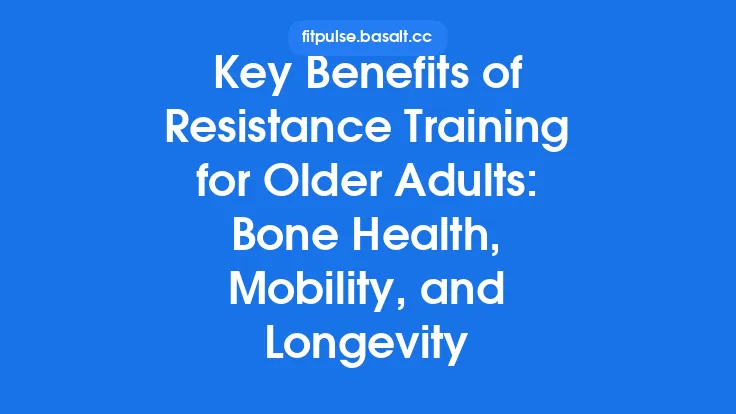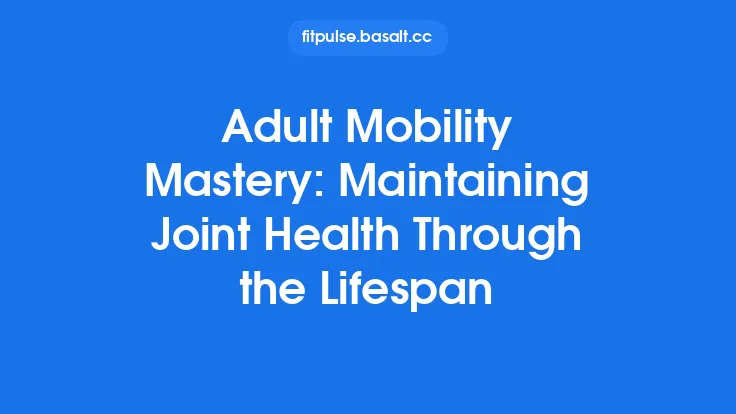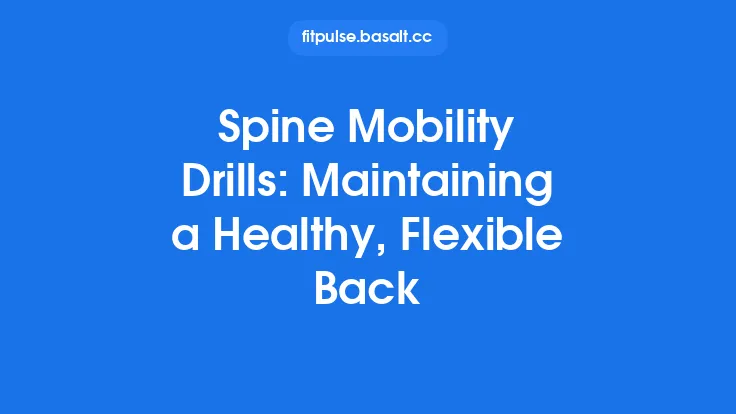Aging is an inevitable biological process, yet the trajectory of functional decline is far from predetermined. While chronological age advances in lockstep, the capacity to move freely, perform daily tasks, and live independently can be preserved—or even enhanced—through targeted exercise interventions. This article delves into the physiological underpinnings of age‑related mobility loss, outlines the specific exercise modalities that most effectively counteract those changes, and provides a practical framework for designing, monitoring, and adapting programs that keep older adults moving with confidence and autonomy.
Understanding Age‑Related Changes in Musculoskeletal Function
Sarcopenia and Muscle Quality
From the third decade of life onward, skeletal muscle undergoes a gradual loss of mass (≈1 % per year) and, more critically, a decline in contractile quality. The reduction in type II (fast‑twitch) fibers, infiltration of intramuscular fat, and altered excitation‑contraction coupling diminish both strength and power—key determinants of functional tasks such as rising from a chair or climbing stairs.
Bone Remodeling and Structural Integrity
Bone turnover slows with age, leading to a net loss of mineral density, particularly in trabecular-rich sites (e.g., vertebrae, femoral neck). While this article does not focus on cardiovascular disease, the mechanical loading provided by resistance and impact‑type exercises is essential for maintaining bone geometry and reducing fracture susceptibility, which directly influences independence.
Neuromuscular Adaptations
Age‑related declines in motor unit recruitment, firing rates, and proprioceptive acuity impair coordination and balance. The central nervous system’s ability to integrate sensory feedback and generate rapid corrective responses deteriorates, increasing the likelihood of missteps and falls.
Joint Mobility and Connective Tissue
Collagen cross‑linking and reduced synovial fluid production lead to decreased joint range of motion (ROM) and increased stiffness. These changes can limit the ability to perform activities that require full limb excursion, such as reaching overhead or bending to tie shoes.
Understanding these interrelated changes provides the rationale for a multimodal exercise prescription that simultaneously addresses strength, power, balance, flexibility, and endurance.
Core Exercise Modalities for Preserving Mobility
A comprehensive program for healthy aging should incorporate four primary pillars:
- Resistance (Strength) Training – to rebuild muscle mass, improve force production, and stimulate bone remodeling.
- Power/Velocity Training – to restore the rapid force generation needed for dynamic tasks.
- Balance and Proprioceptive Training – to refine neuromuscular control and reduce fall risk.
- Flexibility/Joint Mobility Work – to maintain functional ROM and ease of movement.
Each pillar can be delivered through a variety of equipment (free weights, machines, resistance bands, body weight) and environments (home, gym, community center), allowing for individualized program design.
Strength Training: Counteracting Sarcopenia and Maintaining Functional Power
Exercise Selection
Compound, multi‑joint movements (e.g., squat, deadlift, chest press, seated row) provide the greatest stimulus for muscle hypertrophy and functional transfer. When equipment is limited, body‑weight variations (e.g., wall push‑ups, chair squats) and resistance bands can achieve comparable loading.
Intensity and Volume
Research indicates that older adults benefit from moderate to high intensities (60–80 % of one‑repetition maximum, 1RM) performed for 2–3 sets of 8–12 repetitions. Progressive overload—incrementally increasing load, repetitions, or reducing rest intervals—ensures continued adaptation.
Periodization
A linear periodization model (e.g., 4‑week blocks transitioning from higher volume/lower intensity to lower volume/higher intensity) balances stimulus and recovery, mitigating overtraining while fostering strength gains.
Functional Transfer
Integrating task‑specific variations (e.g., sit‑to‑stand from a box, step‑ups onto a platform) bridges the gap between gym‑based strength and everyday activities, reinforcing neural pathways used in daily life.
Power Training: Restoring the Speed Component of Movement
While traditional strength training improves maximal force, many functional tasks require rapid force production—known as power. Power declines more steeply than strength after age 60, making it a critical target.
Methodology
- Velocity‑Focused Resistance: Use lighter loads (30–50 % 1RM) moved as quickly as possible for 1–3 sets of 6–10 repetitions.
- Plyometric Variations: Low‑impact jumps, medicine‑ball throws, or rapid step‑downs can be safely incorporated for individuals with adequate joint health.
- Equipment: Devices such as pneumatic resistance machines or velocity‑based training tools provide real‑time feedback, encouraging maximal intent.
Outcome Measures
Improvements in chair‑rise time, gait speed, and stair ascent speed are commonly observed, directly translating to enhanced independence.
Balance and Proprioception: Reducing Fall Risk and Enhancing Confidence
Balance training should be viewed as a skill acquisition process, emphasizing sensory integration, motor planning, and reactive strategies.
Core Components
- Static Balance – standing on one leg, tandem stance, or using a wobble board.
- Dynamic Balance – walking heel‑to‑toe, lateral shuffles, or obstacle courses.
- Reactive Balance – perturbation training (e.g., gentle pushes, slip‑inducing surfaces) to practice rapid corrective steps.
Progression Strategies
- Reduce base of support (e.g., from double to single leg).
- Decrease visual input (eyes closed).
- Add cognitive dual‑tasks (counting backward while balancing).
- Incorporate unstable surfaces (foam pads, balance discs).
Frequency
Two to three sessions per week, each lasting 10–15 minutes, are sufficient to produce measurable gains in postural sway and functional reach.
Flexibility and Joint Range of Motion: Supporting Daily Tasks
Maintaining adequate ROM is essential for activities such as dressing, reaching, and personal hygiene.
Stretching Modalities
- Static Stretching: Hold a stretch at the point of mild discomfort for 20–30 seconds, repeat 2–3 times per muscle group.
- Dynamic Stretching: Controlled, movement‑based stretches (e.g., leg swings) performed as part of warm‑up to prime joints.
- PNF (Proprioceptive Neuromuscular Facilitation): Contract‑relax techniques can enhance stretch tolerance, especially in tight hip flexors and hamstrings.
Target Areas
Focus on hip flexors/extensors, ankle dorsiflexors, thoracic spine extensors, and shoulder girdle mobility—regions most implicated in functional limitations.
Integration
Incorporate flexibility work at the end of each session to capitalize on post‑exercise muscle temperature, facilitating greater stretch efficacy.
Aerobic Conditioning for Endurance without Emphasizing Cardiovascular Disease
While cardiovascular health is a common discussion point, aerobic conditioning also underpins mobility by improving muscular endurance and metabolic efficiency.
Mode Selection
Low‑impact activities—walking, stationary cycling, elliptical training, and aquatic exercise—are ideal for preserving joint health while enhancing stamina.
Intensity Guidelines
Moderate intensity (40–60 % VO₂ reserve) for 20–30 minutes, 3–5 times per week, improves the ability to sustain prolonged functional tasks such as grocery shopping or gardening.
Interval Approaches
Short bouts of higher intensity (e.g., 30 seconds at 70 % effort) interspersed with active recovery can boost aerobic capacity without excessive joint loading.
Integrating Exercise into the Aging Routine: Periodization and Progression
A well‑structured program balances stimulus, recovery, and adaptation. The following framework can be applied across settings:
| Phase | Duration | Focus | Example Sessions |
|---|---|---|---|
| Foundational | 4–6 weeks | Technique, low‑load strength, basic balance | 2× strength (body weight), 1× balance, 2× flexibility |
| Developmental | 6–8 weeks | Moderate load strength, power introduction, dynamic balance | 3× strength (moderate load), 1× power (light load, fast), 1× dynamic balance |
| Performance | 4–6 weeks | Higher load strength, advanced power, reactive balance | 3× heavy strength, 2× power (moderate load, fast), 1× reactive balance |
| Maintenance | Ongoing | Preserve gains, adjust for life events | 2× strength, 1× power, 1× balance, 1× flexibility per week |
Deload weeks (reduced volume/intensity) every 4–6 weeks help mitigate fatigue and support long‑term adherence.
Assessment Tools for Monitoring Mobility and Independence
Objective measurement guides program adjustments and demonstrates progress.
- Timed Up‑and‑Go (TUG) – assesses functional mobility; >13 seconds may indicate increased fall risk.
- 5‑Times Sit‑to‑Stand (5×STS) – gauges lower‑body strength and power; >15 seconds suggests functional limitation.
- Short Physical Performance Battery (SPPB) – combines gait speed, balance, and chair‑rise tests; scores ≤8 denote frailty.
- Gait Speed – 4‑meter walk; <0.8 m/s is associated with loss of independence.
- Handgrip Dynamometry – proxy for overall muscular strength; values below age‑adjusted norms correlate with functional decline.
Regular reassessment (every 8–12 weeks) informs load progression, identifies emerging deficits, and reinforces motivation through tangible feedback.
Technology and Wearables Supporting Older Adult Exercise
Digital tools can augment traditional training by providing feedback, motivation, and safety monitoring.
- Inertial Measurement Units (IMUs) – attached to limbs to quantify movement quality, balance sway, and gait parameters.
- Smart Resistance Devices – electronically controlled bands that adjust tension based on user performance, ensuring appropriate overload.
- Virtual Reality (VR) Balance Platforms – immersive environments that challenge postural control while maintaining engagement.
- Mobile Apps – simple logging platforms that track session frequency, perceived exertion, and functional test scores, enabling remote coaching.
When selecting technology, prioritize user‑friendly interfaces, clear visual/audio cues, and data privacy compliance.
Nutrition and Recovery Considerations for Older Exercisers
Exercise adaptations are potentiated when paired with adequate nutrition and recovery strategies.
- Protein Intake – 1.2–1.5 g·kg⁻¹·day⁻¹ of high‑quality protein (e.g., whey, soy, lean meats) supports muscle protein synthesis, especially when consumed within 30 minutes post‑exercise.
- Vitamin D and Calcium – essential for bone health; supplementation may be warranted based on serum levels and dietary intake.
- Hydration – age‑related blunted thirst response necessitates conscious fluid intake before, during, and after sessions.
- Sleep – 7–9 hours of restorative sleep facilitates hormonal milieu conducive to tissue repair and neuromuscular consolidation.
Designing a Personalized Mobility Program
- Initial Screening – medical clearance, functional baseline (TUG, 5×STS, SPPB).
- Goal Setting – identify specific independence targets (e.g., “climb a flight of stairs without assistance”).
- Exercise Selection – match modalities to goals, preferences, and available resources.
- Progression Plan – outline load increments, balance challenge escalations, and flexibility targets.
- Monitoring Schedule – set reassessment points and criteria for program modification.
- Support System – involve caregivers, family, or community resources to reinforce adherence.
A template worksheet can be provided to guide practitioners and older adults through each step, ensuring a systematic and transparent approach.
Case Illustrations of Successful Mobility Maintenance
Case 1 – “Grace,” 72 years, Community Dweller
Grace reported difficulty rising from low chairs. Baseline 5×STS: 18 seconds. A 12‑week program emphasizing seated leg presses (progressing from 30 % to 70 % 1RM), power drills (medicine‑ball chest passes at 40 % 1RM, maximal velocity), and daily static balance (single‑leg stance on a foam pad) reduced her 5×STS time to 11 seconds and restored independent stair climbing.
Case 2 – “Luis,” 68 years, Retired Engineer
Luis experienced reduced shoulder reach, limiting his ability to retrieve items from high shelves. After a functional assessment, a regimen combining thoracic extension mobilizations, banded shoulder external rotations, and dynamic balance walking with overhead reaches was instituted. Over 10 weeks, his shoulder flexion ROM increased from 120° to 150°, and his functional reach test improved by 12 cm, enabling safe self‑care.
These examples underscore how targeted, progressive exercise can directly translate to everyday independence.
Future Directions in Exercise Science for Healthy Aging
- Precision Exercise Prescription – leveraging genomics and metabolomics to tailor load, volume, and recovery to individual biological age.
- Artificial Intelligence‑Driven Coaching – real‑time algorithmic adjustments based on sensor data, optimizing safety and efficacy.
- Hybrid Virtual‑In‑Person Programs – combining remote monitoring with periodic on‑site assessments to broaden access while maintaining clinical oversight.
- Longitudinal Cohort Studies – focusing on mobility outcomes (e.g., time to loss of independence) rather than disease endpoints, to refine evidence‑based guidelines specific to functional preservation.
Continued interdisciplinary collaboration among exercise physiologists, gerontologists, biomechanists, and technologists will be pivotal in evolving strategies that keep older adults moving confidently throughout their later years.
By integrating evidence‑based strength, power, balance, flexibility, and endurance training within a structured, progressive framework—and by coupling these efforts with appropriate assessment, technology, and nutrition—older adults can markedly slow the decline in mobility, safeguard independence, and enjoy a higher quality of life. The science is clear: purposeful movement, performed consistently and intelligently, is the cornerstone of healthy aging.





